Directed by: Various*
First aired: 1990-91
Contains Spoilers
*Directors listed on imdb are: Allan Eastman, René Bonnière, Allan King, Randy Bradshaw, Allan Kroeker, Jess Woolnough, Joe Dea. The series spans 21 episodes and the whole thing comes in at around 460 minutes.
This is a kid’s TV series and carries the problems, for an adult, inherent in that very fact but we will look at those later.
The story centers around a family unit. Max (Jacob Tierney, who would go on to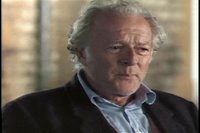 play Snake in the Hunger vampire episode Nunc Dimitis) and Chris (Joe Roncetti) are kids from Philadelphia. Their mother, Eileen (Lynne Cormack), works for a bank and is often in Europe and so moves the kids to Europe so she can be nearer to them, placing them in the care of their Uncle Gustav Helsing (Bernard Behrens) who also looks after a young lady called Sophie (Mia Kirshner).
play Snake in the Hunger vampire episode Nunc Dimitis) and Chris (Joe Roncetti) are kids from Philadelphia. Their mother, Eileen (Lynne Cormack), works for a bank and is often in Europe and so moves the kids to Europe so she can be nearer to them, placing them in the care of their Uncle Gustav Helsing (Bernard Behrens) who also looks after a young lady called Sophie (Mia Kirshner).
Max is, in the first episode, obsessed with vampires and decides that Gustav is a vampire and so seeks help from the billionaire businessman whom he met at a reception with his mother, Alexander Lucard (Geordie Johnson). Of course Max has got it about face and Lucard is actually Count Dracula. They keep the pretence of A. Lucard not being an obvious anagram for the first episode only. The anagram is cracked, so to speak, when Sophie – trapped by the vampire – declares, “You're Dracula”. Dracula gets some great lines and Johnson relishes them, in this case his retort is, “No, I’m Milli Vanilli… Of course I’m Dracula!”
face and Lucard is actually Count Dracula. They keep the pretence of A. Lucard not being an obvious anagram for the first episode only. The anagram is cracked, so to speak, when Sophie – trapped by the vampire – declares, “You're Dracula”. Dracula gets some great lines and Johnson relishes them, in this case his retort is, “No, I’m Milli Vanilli… Of course I’m Dracula!”
 The series then sees the children and Gustav pitting their wits against Dracula, from episode to episode with recurring characters appearing from time to time. One of these is Klaus (Geriant Wyn Davies, who went on to play Nick Knight in the series Forever Knight), a particularly vicious vampire who is also Gustav Helsing’s son.
The series then sees the children and Gustav pitting their wits against Dracula, from episode to episode with recurring characters appearing from time to time. One of these is Klaus (Geriant Wyn Davies, who went on to play Nick Knight in the series Forever Knight), a particularly vicious vampire who is also Gustav Helsing’s son.
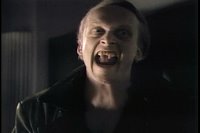 We also meet a vampire named Nosferatu, a rival of Dracula and of course named for F W Murnau’s Classic Film. Not looking exactly to the silent movie form, this is none the less an excellent character who, unfortunately, only appears in one episode. The first confrontation between Dracula and Nosferatu leads to a fantastic exchange in the dialogue with the cracking line from Dracula, “You were a third-rate bungler when you forgot to wake up Hitler on D-Day, and nothing's changed.”
We also meet a vampire named Nosferatu, a rival of Dracula and of course named for F W Murnau’s Classic Film. Not looking exactly to the silent movie form, this is none the less an excellent character who, unfortunately, only appears in one episode. The first confrontation between Dracula and Nosferatu leads to a fantastic exchange in the dialogue with the cracking line from Dracula, “You were a third-rate bungler when you forgot to wake up Hitler on D-Day, and nothing's changed.”
The series introduces a lot of vampire lore, some traditional and some not, some works and some doesn’t. We see the vampires move in the daylight, this at first delighted me as I assumed that the producers were following the precepts introduced by Stoker. I was less impressed when I discovered that Dracula had ensured his scientists had invented an effective sun-block for vampires. That said the series does hold true to the concept that, during the day, the vampire’s supernatural powers are curtailed.
Crosses certainly hold the undead at bay and the Helsing house has a holy relic, the Cross of the Magyar, which prevents a vampire from entering his home – thus ensuring that the characters have a safe area from which the series can continue (unless, that is, the vampire is invited in when the cross is rendered useless). Holy water stuns the vampires and makes them smoke, ingesting it kills them. They can move as sparks of light and transform into a flock of bats (animated). We see Dracula transform into a dog and one bungling vampire of low power transforms himself into a white rabbit by accident (to a derisive aside from Dracula of “Amateurs”).
Vampires cast no reflection but this is a gradual process their reflections (and ability to be photographed) diminishing as they come into their powers and they have telepathy. Staking through the heart is a sure fire method of destruction. A circle of holy water around the vampire or being shut in a casket sealed with a silver nail will trap the vampire.
The concept that a vampire’s buried treasure gives off a blue flame on St George’s Eve is held but they also introduce the idea that if it is a full moon on St George’s Eve the vampire must return to his or her own grave. Wild Roses placed upon a grave will stop a vampire rising.
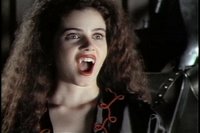 There seems to be a variety of effects of a vampire’s bite. The victim, if they die, will either simply die or rise as a vampire by the will of the vampire. If they survive they might just have amnesia, or simply be weak. They may also find themselves under the vampire’s control. Holy water on the wounds will destroy that control, removing the wounds.
There seems to be a variety of effects of a vampire’s bite. The victim, if they die, will either simply die or rise as a vampire by the will of the vampire. If they survive they might just have amnesia, or simply be weak. They may also find themselves under the vampire’s control. Holy water on the wounds will destroy that control, removing the wounds.
Several of the characters are vampirised in the series. There is a potion, with a virtually extinct herb as part of the ingredients, that can restore a person’s life and humanity if taken before the transformation is complete – this is used in one episode.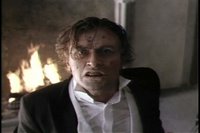 Love can, on rare occasions, restore humanity. In one episode, "Bad Blood", Dracula bites someone with a rare blood type that contains an antigen poisonous to vampires, only the water from a certain spring contains a cure. When Sophie is vampirised by the person who poisoned Dracula, thus who had that blood type, it seems that the spring will cure her. (Incidentally, in the episode during which Dracula is poisoned we meet a vampire doctor named Varney - obviously after Varney the Vampyre.)
Love can, on rare occasions, restore humanity. In one episode, "Bad Blood", Dracula bites someone with a rare blood type that contains an antigen poisonous to vampires, only the water from a certain spring contains a cure. When Sophie is vampirised by the person who poisoned Dracula, thus who had that blood type, it seems that the spring will cure her. (Incidentally, in the episode during which Dracula is poisoned we meet a vampire doctor named Varney - obviously after Varney the Vampyre.)
Dracula also makes zombies, though these seem more like revenants and, whilst stupid, are only killable via the stake in the heart method. Another interesting character was the vampire who despised his condition and so developed a split personality – the human personality eventually wanting to be a vampire.
 Some of the additions, such as the vampire sun-gun, seem a little silly however. This brings us onto the cons. Whilst the vampire fang and eye effects are effective, the early cgi used to animate dusting for example looks bad now-a-days. The bat animations jar a little as they are obviously animations.
Some of the additions, such as the vampire sun-gun, seem a little silly however. This brings us onto the cons. Whilst the vampire fang and eye effects are effective, the early cgi used to animate dusting for example looks bad now-a-days. The bat animations jar a little as they are obviously animations.
There are no viewed bites, this is kids TV after all, and there is no real blood to see (bar from a hip flask in the last episode). Of course we also have to deal with kids, though as the series progressed it seemed to concentrate on the adults a bit more.
The biggest problem came from the nature of this being a series. Lucard is a powerful vampire and a billionaire. If he wanted to wipe out the family it would be done, of course that would have led to a very short series. As such the plot is contrived so that the main characters will always get away but Dracula always survives. Tied in with that is the fact that the episodes are rather short, so expansion of a concept in an episode can be curtailed. That said the length also ensures that there is no room for adding in things as filler elements.
The acting can be patchy. For a series set in Europe there are an awful lot of US accents. Some of the additional characters seem poor or much too kid’s TV for taste. The kids themselves were great, for child actors, and whilst they could be annoying at times it had more to do with script than their performances. That said there two stand-out performances. Behrens performance as Helsing is superb in turns making his character desperate and haunted yet also putting across a warmth and mischievous aspect that would really make him a favourite uncle.
Johnson makes a great Dracula. There is an arrogance to him that really works and he has some great lines only enhanced by his great delivery. Some of the stand-out ones were:
Gustav Helsing, trying to save an old friend under Dracula’s control cries out, “She’s not a vampire yet, until you kill her you only control her mind – not her soul.” Dracula’s great response, “Don’t quibble.” Whilst closing a factory Dracula dictates a letter, “And although I'm aware of the fact that closing the plant in Arvennes will put hundreds out of work, and perhaps kill the town, one must realise that... it was an ugly little town, anyway.” The last one I’ll mention, whilst contemplating Government corruption, Dracula muses, “Democracy. The worst political system in the world... except for all the others.”
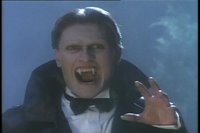 One of the episodes towards the end, “I Love Lucard”, builds some real depth to the Dracula character bringing us away from the standard two dimensional villain, as Dracula is too often portrayed in the inumerate films about the character, and showed some intricacies that were exceptionally fascinating. There is a dialogue between Dracula and Helsing in the episode “Fall of the Romanian Vampire” that showcases the talent of Johnson and Behrens.
One of the episodes towards the end, “I Love Lucard”, builds some real depth to the Dracula character bringing us away from the standard two dimensional villain, as Dracula is too often portrayed in the inumerate films about the character, and showed some intricacies that were exceptionally fascinating. There is a dialogue between Dracula and Helsing in the episode “Fall of the Romanian Vampire” that showcases the talent of Johnson and Behrens.
The series ends on a cliff-hanger that will never be resolved as it only ran for one series (Actually the cliff-hanger is at episode twenty, the final episode is a clip-show unfortunately). However, the bottom line is that this, even for an adult, is fun and it is great to have something that, as an adult vampire fan, you can safely share with your kids – knowing that there is an edge of darkness even within the silliest excesses of the show that the kids will love. This really is family entertainment vampire style. 6.5 out of 10 for the series as a whole, though the episodes towards the end of the series veer to perhaps a 7.
The imdb page is here.
First aired: 1990-91
Contains Spoilers
*Directors listed on imdb are: Allan Eastman, René Bonnière, Allan King, Randy Bradshaw, Allan Kroeker, Jess Woolnough, Joe Dea. The series spans 21 episodes and the whole thing comes in at around 460 minutes.
This is a kid’s TV series and carries the problems, for an adult, inherent in that very fact but we will look at those later.
The story centers around a family unit. Max (Jacob Tierney, who would go on to
 play Snake in the Hunger vampire episode Nunc Dimitis) and Chris (Joe Roncetti) are kids from Philadelphia. Their mother, Eileen (Lynne Cormack), works for a bank and is often in Europe and so moves the kids to Europe so she can be nearer to them, placing them in the care of their Uncle Gustav Helsing (Bernard Behrens) who also looks after a young lady called Sophie (Mia Kirshner).
play Snake in the Hunger vampire episode Nunc Dimitis) and Chris (Joe Roncetti) are kids from Philadelphia. Their mother, Eileen (Lynne Cormack), works for a bank and is often in Europe and so moves the kids to Europe so she can be nearer to them, placing them in the care of their Uncle Gustav Helsing (Bernard Behrens) who also looks after a young lady called Sophie (Mia Kirshner).Max is, in the first episode, obsessed with vampires and decides that Gustav is a vampire and so seeks help from the billionaire businessman whom he met at a reception with his mother, Alexander Lucard (Geordie Johnson). Of course Max has got it about
 face and Lucard is actually Count Dracula. They keep the pretence of A. Lucard not being an obvious anagram for the first episode only. The anagram is cracked, so to speak, when Sophie – trapped by the vampire – declares, “You're Dracula”. Dracula gets some great lines and Johnson relishes them, in this case his retort is, “No, I’m Milli Vanilli… Of course I’m Dracula!”
face and Lucard is actually Count Dracula. They keep the pretence of A. Lucard not being an obvious anagram for the first episode only. The anagram is cracked, so to speak, when Sophie – trapped by the vampire – declares, “You're Dracula”. Dracula gets some great lines and Johnson relishes them, in this case his retort is, “No, I’m Milli Vanilli… Of course I’m Dracula!” The series then sees the children and Gustav pitting their wits against Dracula, from episode to episode with recurring characters appearing from time to time. One of these is Klaus (Geriant Wyn Davies, who went on to play Nick Knight in the series Forever Knight), a particularly vicious vampire who is also Gustav Helsing’s son.
The series then sees the children and Gustav pitting their wits against Dracula, from episode to episode with recurring characters appearing from time to time. One of these is Klaus (Geriant Wyn Davies, who went on to play Nick Knight in the series Forever Knight), a particularly vicious vampire who is also Gustav Helsing’s son. We also meet a vampire named Nosferatu, a rival of Dracula and of course named for F W Murnau’s Classic Film. Not looking exactly to the silent movie form, this is none the less an excellent character who, unfortunately, only appears in one episode. The first confrontation between Dracula and Nosferatu leads to a fantastic exchange in the dialogue with the cracking line from Dracula, “You were a third-rate bungler when you forgot to wake up Hitler on D-Day, and nothing's changed.”
We also meet a vampire named Nosferatu, a rival of Dracula and of course named for F W Murnau’s Classic Film. Not looking exactly to the silent movie form, this is none the less an excellent character who, unfortunately, only appears in one episode. The first confrontation between Dracula and Nosferatu leads to a fantastic exchange in the dialogue with the cracking line from Dracula, “You were a third-rate bungler when you forgot to wake up Hitler on D-Day, and nothing's changed.”The series introduces a lot of vampire lore, some traditional and some not, some works and some doesn’t. We see the vampires move in the daylight, this at first delighted me as I assumed that the producers were following the precepts introduced by Stoker. I was less impressed when I discovered that Dracula had ensured his scientists had invented an effective sun-block for vampires. That said the series does hold true to the concept that, during the day, the vampire’s supernatural powers are curtailed.
Crosses certainly hold the undead at bay and the Helsing house has a holy relic, the Cross of the Magyar, which prevents a vampire from entering his home – thus ensuring that the characters have a safe area from which the series can continue (unless, that is, the vampire is invited in when the cross is rendered useless). Holy water stuns the vampires and makes them smoke, ingesting it kills them. They can move as sparks of light and transform into a flock of bats (animated). We see Dracula transform into a dog and one bungling vampire of low power transforms himself into a white rabbit by accident (to a derisive aside from Dracula of “Amateurs”).
Vampires cast no reflection but this is a gradual process their reflections (and ability to be photographed) diminishing as they come into their powers and they have telepathy. Staking through the heart is a sure fire method of destruction. A circle of holy water around the vampire or being shut in a casket sealed with a silver nail will trap the vampire.
The concept that a vampire’s buried treasure gives off a blue flame on St George’s Eve is held but they also introduce the idea that if it is a full moon on St George’s Eve the vampire must return to his or her own grave. Wild Roses placed upon a grave will stop a vampire rising.
 There seems to be a variety of effects of a vampire’s bite. The victim, if they die, will either simply die or rise as a vampire by the will of the vampire. If they survive they might just have amnesia, or simply be weak. They may also find themselves under the vampire’s control. Holy water on the wounds will destroy that control, removing the wounds.
There seems to be a variety of effects of a vampire’s bite. The victim, if they die, will either simply die or rise as a vampire by the will of the vampire. If they survive they might just have amnesia, or simply be weak. They may also find themselves under the vampire’s control. Holy water on the wounds will destroy that control, removing the wounds.Several of the characters are vampirised in the series. There is a potion, with a virtually extinct herb as part of the ingredients, that can restore a person’s life and humanity if taken before the transformation is complete – this is used in one episode.
 Love can, on rare occasions, restore humanity. In one episode, "Bad Blood", Dracula bites someone with a rare blood type that contains an antigen poisonous to vampires, only the water from a certain spring contains a cure. When Sophie is vampirised by the person who poisoned Dracula, thus who had that blood type, it seems that the spring will cure her. (Incidentally, in the episode during which Dracula is poisoned we meet a vampire doctor named Varney - obviously after Varney the Vampyre.)
Love can, on rare occasions, restore humanity. In one episode, "Bad Blood", Dracula bites someone with a rare blood type that contains an antigen poisonous to vampires, only the water from a certain spring contains a cure. When Sophie is vampirised by the person who poisoned Dracula, thus who had that blood type, it seems that the spring will cure her. (Incidentally, in the episode during which Dracula is poisoned we meet a vampire doctor named Varney - obviously after Varney the Vampyre.)Dracula also makes zombies, though these seem more like revenants and, whilst stupid, are only killable via the stake in the heart method. Another interesting character was the vampire who despised his condition and so developed a split personality – the human personality eventually wanting to be a vampire.
 Some of the additions, such as the vampire sun-gun, seem a little silly however. This brings us onto the cons. Whilst the vampire fang and eye effects are effective, the early cgi used to animate dusting for example looks bad now-a-days. The bat animations jar a little as they are obviously animations.
Some of the additions, such as the vampire sun-gun, seem a little silly however. This brings us onto the cons. Whilst the vampire fang and eye effects are effective, the early cgi used to animate dusting for example looks bad now-a-days. The bat animations jar a little as they are obviously animations.There are no viewed bites, this is kids TV after all, and there is no real blood to see (bar from a hip flask in the last episode). Of course we also have to deal with kids, though as the series progressed it seemed to concentrate on the adults a bit more.
The biggest problem came from the nature of this being a series. Lucard is a powerful vampire and a billionaire. If he wanted to wipe out the family it would be done, of course that would have led to a very short series. As such the plot is contrived so that the main characters will always get away but Dracula always survives. Tied in with that is the fact that the episodes are rather short, so expansion of a concept in an episode can be curtailed. That said the length also ensures that there is no room for adding in things as filler elements.
The acting can be patchy. For a series set in Europe there are an awful lot of US accents. Some of the additional characters seem poor or much too kid’s TV for taste. The kids themselves were great, for child actors, and whilst they could be annoying at times it had more to do with script than their performances. That said there two stand-out performances. Behrens performance as Helsing is superb in turns making his character desperate and haunted yet also putting across a warmth and mischievous aspect that would really make him a favourite uncle.
Johnson makes a great Dracula. There is an arrogance to him that really works and he has some great lines only enhanced by his great delivery. Some of the stand-out ones were:
Gustav Helsing, trying to save an old friend under Dracula’s control cries out, “She’s not a vampire yet, until you kill her you only control her mind – not her soul.” Dracula’s great response, “Don’t quibble.” Whilst closing a factory Dracula dictates a letter, “And although I'm aware of the fact that closing the plant in Arvennes will put hundreds out of work, and perhaps kill the town, one must realise that... it was an ugly little town, anyway.” The last one I’ll mention, whilst contemplating Government corruption, Dracula muses, “Democracy. The worst political system in the world... except for all the others.”
 One of the episodes towards the end, “I Love Lucard”, builds some real depth to the Dracula character bringing us away from the standard two dimensional villain, as Dracula is too often portrayed in the inumerate films about the character, and showed some intricacies that were exceptionally fascinating. There is a dialogue between Dracula and Helsing in the episode “Fall of the Romanian Vampire” that showcases the talent of Johnson and Behrens.
One of the episodes towards the end, “I Love Lucard”, builds some real depth to the Dracula character bringing us away from the standard two dimensional villain, as Dracula is too often portrayed in the inumerate films about the character, and showed some intricacies that were exceptionally fascinating. There is a dialogue between Dracula and Helsing in the episode “Fall of the Romanian Vampire” that showcases the talent of Johnson and Behrens.The series ends on a cliff-hanger that will never be resolved as it only ran for one series (Actually the cliff-hanger is at episode twenty, the final episode is a clip-show unfortunately). However, the bottom line is that this, even for an adult, is fun and it is great to have something that, as an adult vampire fan, you can safely share with your kids – knowing that there is an edge of darkness even within the silliest excesses of the show that the kids will love. This really is family entertainment vampire style. 6.5 out of 10 for the series as a whole, though the episodes towards the end of the series veer to perhaps a 7.
The imdb page is here.

















4 comments:
Hi, dear, it's me again... Yeah, I bought this once from a local pawn broker and a review I once read was right: the kids in the show metaphorically "light bags of (shite) on Lucard's doorstep" and run while he's stomping it out. ...Metaphorically! LOL
Hi AV - that is true to a degree, but it is a kids show and some degree of lee-way has to be given.
That said it was fun and there were some dark themes added as the series went along (I'm sure a writer wantede to make this more adult towards the end.)
I own this series and love it. It's a dumb, kid's show, but Johnson makes an effective Dracula. He looks suave and smooth as Lucard, but scary in full vampire makeup. It's as realistic as a cartoon, so I don't mind that nobody ever wins. My crush on Mia Kirshner began with this show, and persists to this day!
Stephen, can't disagree :)
Post a Comment